Brand Management: Strategies for Building and Managing Brands Report
VerifiedAdded on 2020/06/04
|20
|5263
|614
Report
AI Summary
This report provides a comprehensive overview of brand management, exploring the core concepts of brand building and its significance as a marketing tool. It delves into the definition of a brand, its differentiation from a product, and the key elements of a strong brand. The report examines how brands are managed and developed over time, including challenges in brand development. Furthermore, it evaluates brand management strategies using theories and models, with a focus on the portfolio strategies, management hierarchies, and brand equity management of Apple and Microsoft, including the application of the CBBE model. The report also analyzes extension approaches, brand reinforcement, and collaboration techniques. Finally, it assesses brand measurement techniques and approaches to valuing brands, concluding with a critical evaluation of techniques for measuring and managing brand value to develop a strong and enduring brand.

BRAND MANAGEMENT
Paraphrase This Document
Need a fresh take? Get an instant paraphrase of this document with our AI Paraphraser
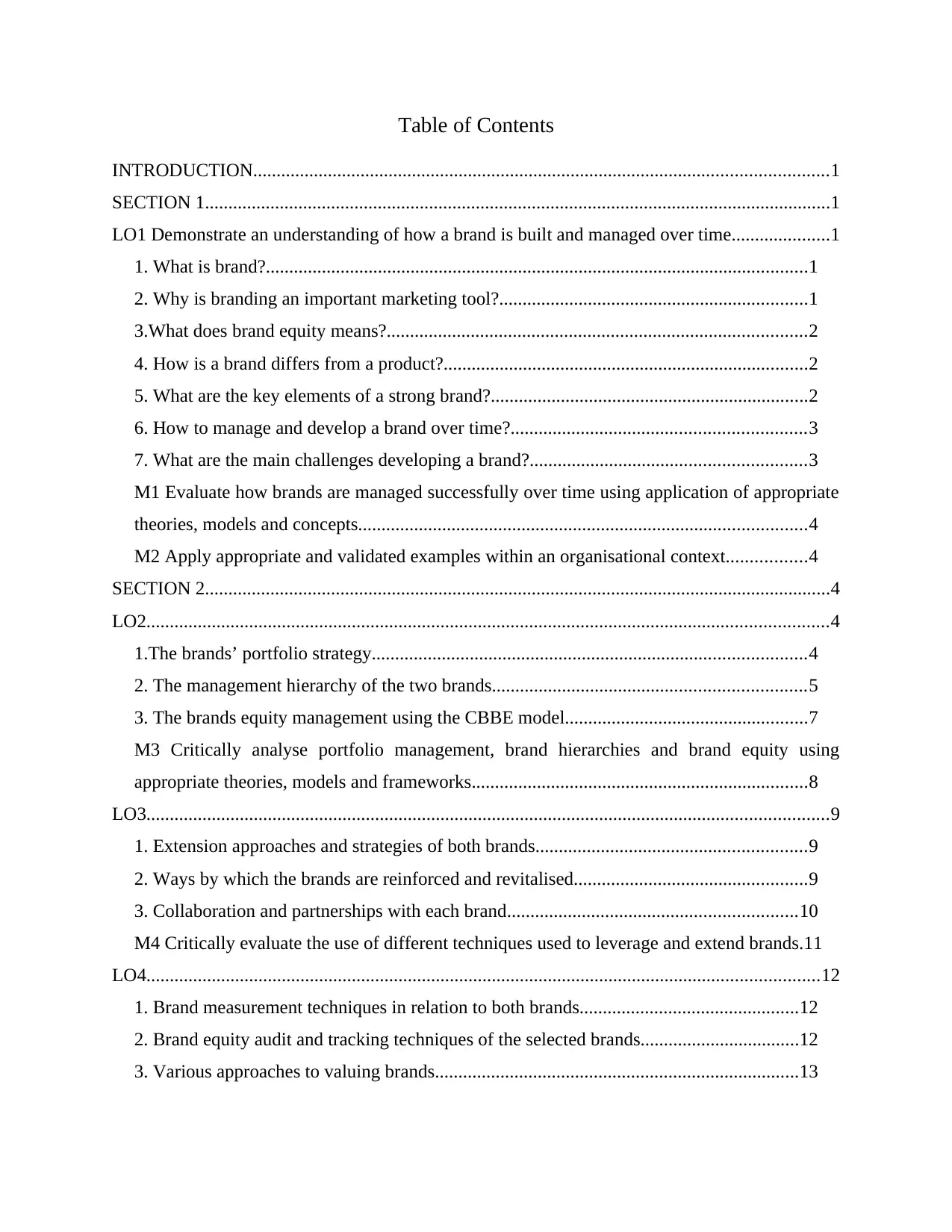
Table of Contents
INTRODUCTION...........................................................................................................................1
SECTION 1......................................................................................................................................1
LO1 Demonstrate an understanding of how a brand is built and managed over time.....................1
1. What is brand?....................................................................................................................1
2. Why is branding an important marketing tool?..................................................................1
3.What does brand equity means?..........................................................................................2
4. How is a brand differs from a product?..............................................................................2
5. What are the key elements of a strong brand?....................................................................2
6. How to manage and develop a brand over time?...............................................................3
7. What are the main challenges developing a brand?...........................................................3
M1 Evaluate how brands are managed successfully over time using application of appropriate
theories, models and concepts................................................................................................4
M2 Apply appropriate and validated examples within an organisational context.................4
SECTION 2......................................................................................................................................4
LO2..................................................................................................................................................4
1.The brands’ portfolio strategy.............................................................................................4
2. The management hierarchy of the two brands...................................................................5
3. The brands equity management using the CBBE model....................................................7
M3 Critically analyse portfolio management, brand hierarchies and brand equity using
appropriate theories, models and frameworks........................................................................8
LO3..................................................................................................................................................9
1. Extension approaches and strategies of both brands..........................................................9
2. Ways by which the brands are reinforced and revitalised..................................................9
3. Collaboration and partnerships with each brand..............................................................10
M4 Critically evaluate the use of different techniques used to leverage and extend brands.11
LO4................................................................................................................................................12
1. Brand measurement techniques in relation to both brands...............................................12
2. Brand equity audit and tracking techniques of the selected brands..................................12
3. Various approaches to valuing brands..............................................................................13
INTRODUCTION...........................................................................................................................1
SECTION 1......................................................................................................................................1
LO1 Demonstrate an understanding of how a brand is built and managed over time.....................1
1. What is brand?....................................................................................................................1
2. Why is branding an important marketing tool?..................................................................1
3.What does brand equity means?..........................................................................................2
4. How is a brand differs from a product?..............................................................................2
5. What are the key elements of a strong brand?....................................................................2
6. How to manage and develop a brand over time?...............................................................3
7. What are the main challenges developing a brand?...........................................................3
M1 Evaluate how brands are managed successfully over time using application of appropriate
theories, models and concepts................................................................................................4
M2 Apply appropriate and validated examples within an organisational context.................4
SECTION 2......................................................................................................................................4
LO2..................................................................................................................................................4
1.The brands’ portfolio strategy.............................................................................................4
2. The management hierarchy of the two brands...................................................................5
3. The brands equity management using the CBBE model....................................................7
M3 Critically analyse portfolio management, brand hierarchies and brand equity using
appropriate theories, models and frameworks........................................................................8
LO3..................................................................................................................................................9
1. Extension approaches and strategies of both brands..........................................................9
2. Ways by which the brands are reinforced and revitalised..................................................9
3. Collaboration and partnerships with each brand..............................................................10
M4 Critically evaluate the use of different techniques used to leverage and extend brands.11
LO4................................................................................................................................................12
1. Brand measurement techniques in relation to both brands...............................................12
2. Brand equity audit and tracking techniques of the selected brands..................................12
3. Various approaches to valuing brands..............................................................................13

M5 Critically evaluate application of techniques for measuring and managing brand value in
relation to developing a strong and enduring brand.............................................................13
COCLUSION.................................................................................................................................14
REFERENCES..............................................................................................................................15
relation to developing a strong and enduring brand.............................................................13
COCLUSION.................................................................................................................................14
REFERENCES..............................................................................................................................15
⊘ This is a preview!⊘
Do you want full access?
Subscribe today to unlock all pages.

Trusted by 1+ million students worldwide
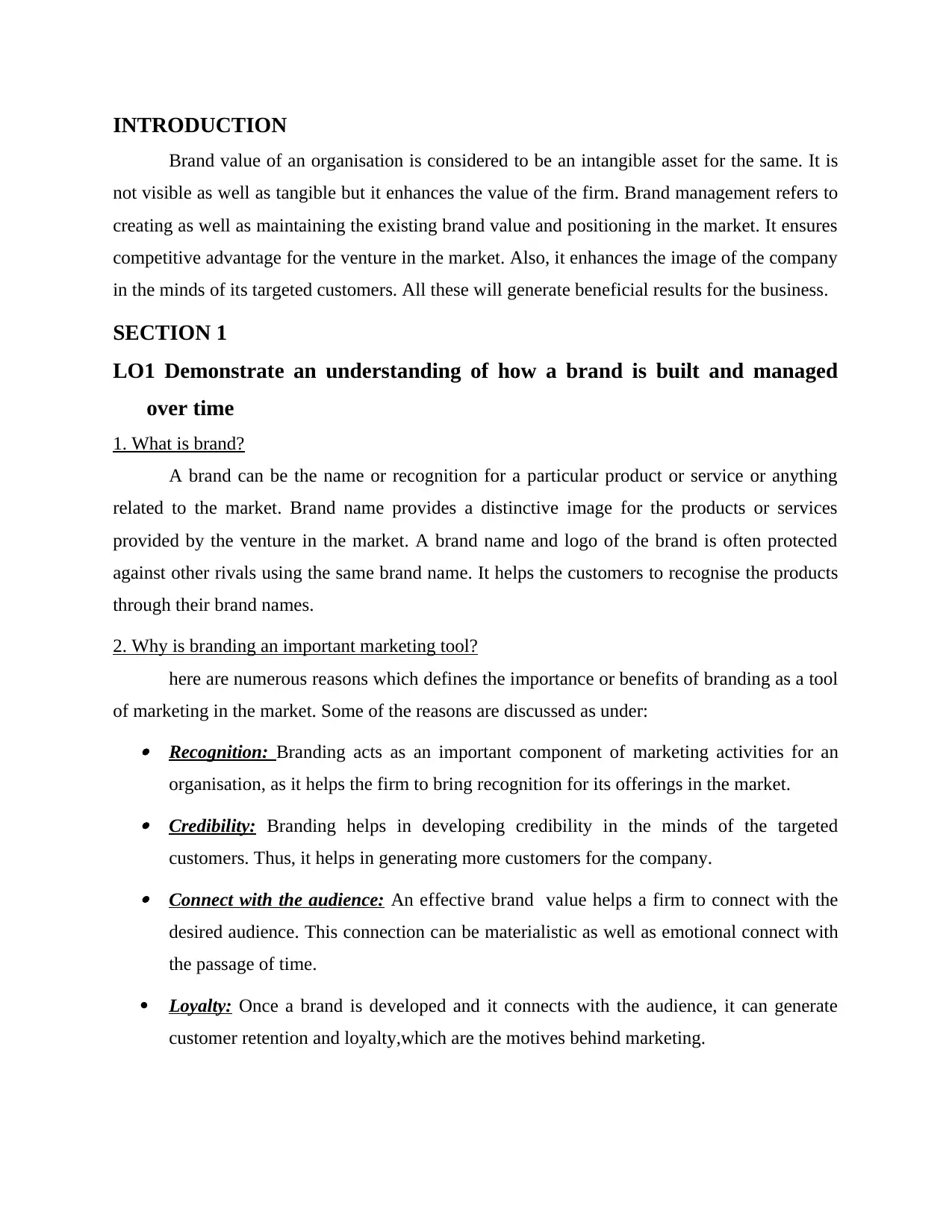
INTRODUCTION
Brand value of an organisation is considered to be an intangible asset for the same. It is
not visible as well as tangible but it enhances the value of the firm. Brand management refers to
creating as well as maintaining the existing brand value and positioning in the market. It ensures
competitive advantage for the venture in the market. Also, it enhances the image of the company
in the minds of its targeted customers. All these will generate beneficial results for the business.
SECTION 1
LO1 Demonstrate an understanding of how a brand is built and managed
over time
1. What is brand?
A brand can be the name or recognition for a particular product or service or anything
related to the market. Brand name provides a distinctive image for the products or services
provided by the venture in the market. A brand name and logo of the brand is often protected
against other rivals using the same brand name. It helps the customers to recognise the products
through their brand names.
2. Why is branding an important marketing tool?
here are numerous reasons which defines the importance or benefits of branding as a tool
of marketing in the market. Some of the reasons are discussed as under: Recognition: Branding acts as an important component of marketing activities for an
organisation, as it helps the firm to bring recognition for its offerings in the market. Credibility: Branding helps in developing credibility in the minds of the targeted
customers. Thus, it helps in generating more customers for the company. Connect with the audience: An effective brand value helps a firm to connect with the
desired audience. This connection can be materialistic as well as emotional connect with
the passage of time.
Loyalty: Once a brand is developed and it connects with the audience, it can generate
customer retention and loyalty,which are the motives behind marketing.
Brand value of an organisation is considered to be an intangible asset for the same. It is
not visible as well as tangible but it enhances the value of the firm. Brand management refers to
creating as well as maintaining the existing brand value and positioning in the market. It ensures
competitive advantage for the venture in the market. Also, it enhances the image of the company
in the minds of its targeted customers. All these will generate beneficial results for the business.
SECTION 1
LO1 Demonstrate an understanding of how a brand is built and managed
over time
1. What is brand?
A brand can be the name or recognition for a particular product or service or anything
related to the market. Brand name provides a distinctive image for the products or services
provided by the venture in the market. A brand name and logo of the brand is often protected
against other rivals using the same brand name. It helps the customers to recognise the products
through their brand names.
2. Why is branding an important marketing tool?
here are numerous reasons which defines the importance or benefits of branding as a tool
of marketing in the market. Some of the reasons are discussed as under: Recognition: Branding acts as an important component of marketing activities for an
organisation, as it helps the firm to bring recognition for its offerings in the market. Credibility: Branding helps in developing credibility in the minds of the targeted
customers. Thus, it helps in generating more customers for the company. Connect with the audience: An effective brand value helps a firm to connect with the
desired audience. This connection can be materialistic as well as emotional connect with
the passage of time.
Loyalty: Once a brand is developed and it connects with the audience, it can generate
customer retention and loyalty,which are the motives behind marketing.
Paraphrase This Document
Need a fresh take? Get an instant paraphrase of this document with our AI Paraphraser
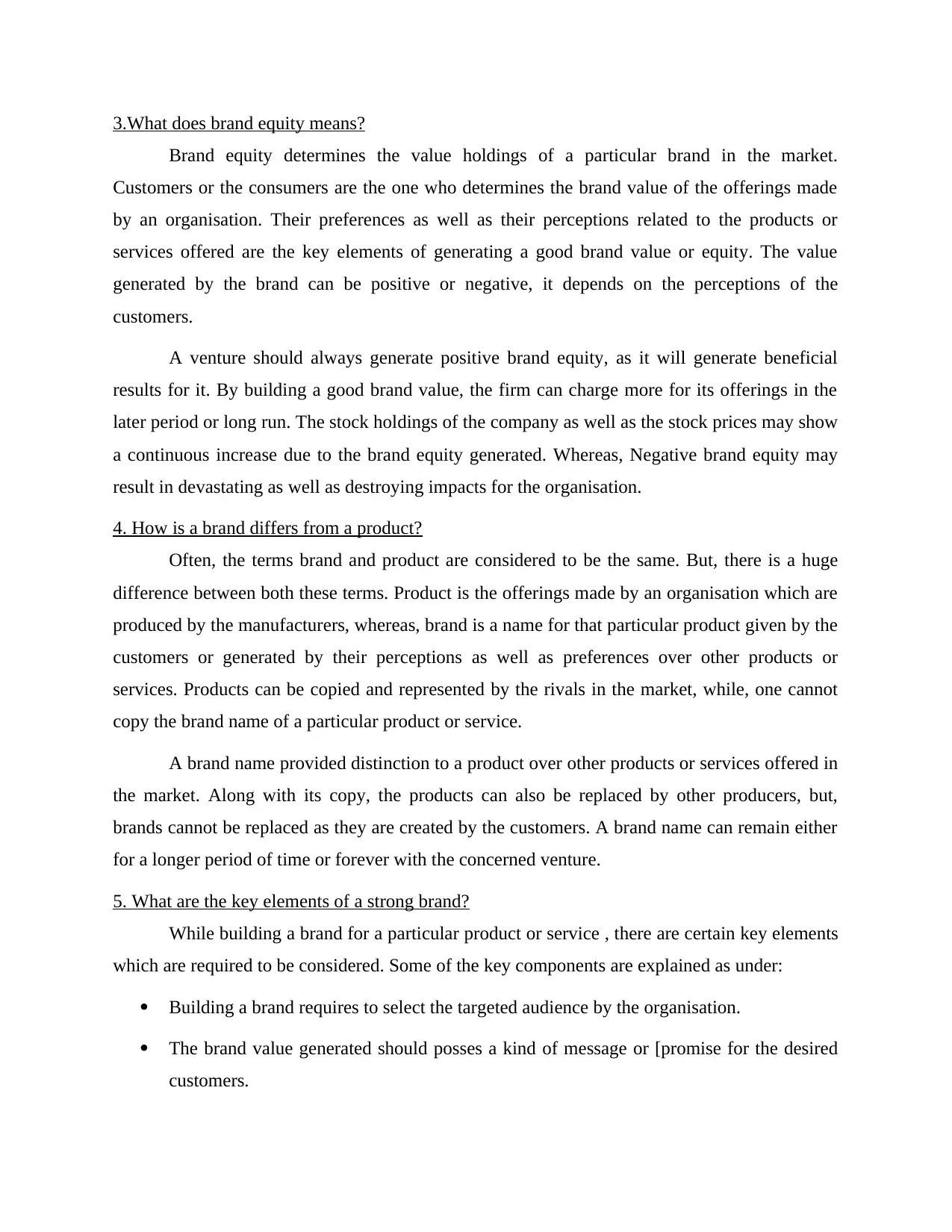
3.What does brand equity means?
Brand equity determines the value holdings of a particular brand in the market.
Customers or the consumers are the one who determines the brand value of the offerings made
by an organisation. Their preferences as well as their perceptions related to the products or
services offered are the key elements of generating a good brand value or equity. The value
generated by the brand can be positive or negative, it depends on the perceptions of the
customers.
A venture should always generate positive brand equity, as it will generate beneficial
results for it. By building a good brand value, the firm can charge more for its offerings in the
later period or long run. The stock holdings of the company as well as the stock prices may show
a continuous increase due to the brand equity generated. Whereas, Negative brand equity may
result in devastating as well as destroying impacts for the organisation.
4. How is a brand differs from a product?
Often, the terms brand and product are considered to be the same. But, there is a huge
difference between both these terms. Product is the offerings made by an organisation which are
produced by the manufacturers, whereas, brand is a name for that particular product given by the
customers or generated by their perceptions as well as preferences over other products or
services. Products can be copied and represented by the rivals in the market, while, one cannot
copy the brand name of a particular product or service.
A brand name provided distinction to a product over other products or services offered in
the market. Along with its copy, the products can also be replaced by other producers, but,
brands cannot be replaced as they are created by the customers. A brand name can remain either
for a longer period of time or forever with the concerned venture.
5. What are the key elements of a strong brand?
While building a brand for a particular product or service , there are certain key elements
which are required to be considered. Some of the key components are explained as under:
Building a brand requires to select the targeted audience by the organisation.
The brand value generated should posses a kind of message or [promise for the desired
customers.
Brand equity determines the value holdings of a particular brand in the market.
Customers or the consumers are the one who determines the brand value of the offerings made
by an organisation. Their preferences as well as their perceptions related to the products or
services offered are the key elements of generating a good brand value or equity. The value
generated by the brand can be positive or negative, it depends on the perceptions of the
customers.
A venture should always generate positive brand equity, as it will generate beneficial
results for it. By building a good brand value, the firm can charge more for its offerings in the
later period or long run. The stock holdings of the company as well as the stock prices may show
a continuous increase due to the brand equity generated. Whereas, Negative brand equity may
result in devastating as well as destroying impacts for the organisation.
4. How is a brand differs from a product?
Often, the terms brand and product are considered to be the same. But, there is a huge
difference between both these terms. Product is the offerings made by an organisation which are
produced by the manufacturers, whereas, brand is a name for that particular product given by the
customers or generated by their perceptions as well as preferences over other products or
services. Products can be copied and represented by the rivals in the market, while, one cannot
copy the brand name of a particular product or service.
A brand name provided distinction to a product over other products or services offered in
the market. Along with its copy, the products can also be replaced by other producers, but,
brands cannot be replaced as they are created by the customers. A brand name can remain either
for a longer period of time or forever with the concerned venture.
5. What are the key elements of a strong brand?
While building a brand for a particular product or service , there are certain key elements
which are required to be considered. Some of the key components are explained as under:
Building a brand requires to select the targeted audience by the organisation.
The brand value generated should posses a kind of message or [promise for the desired
customers.
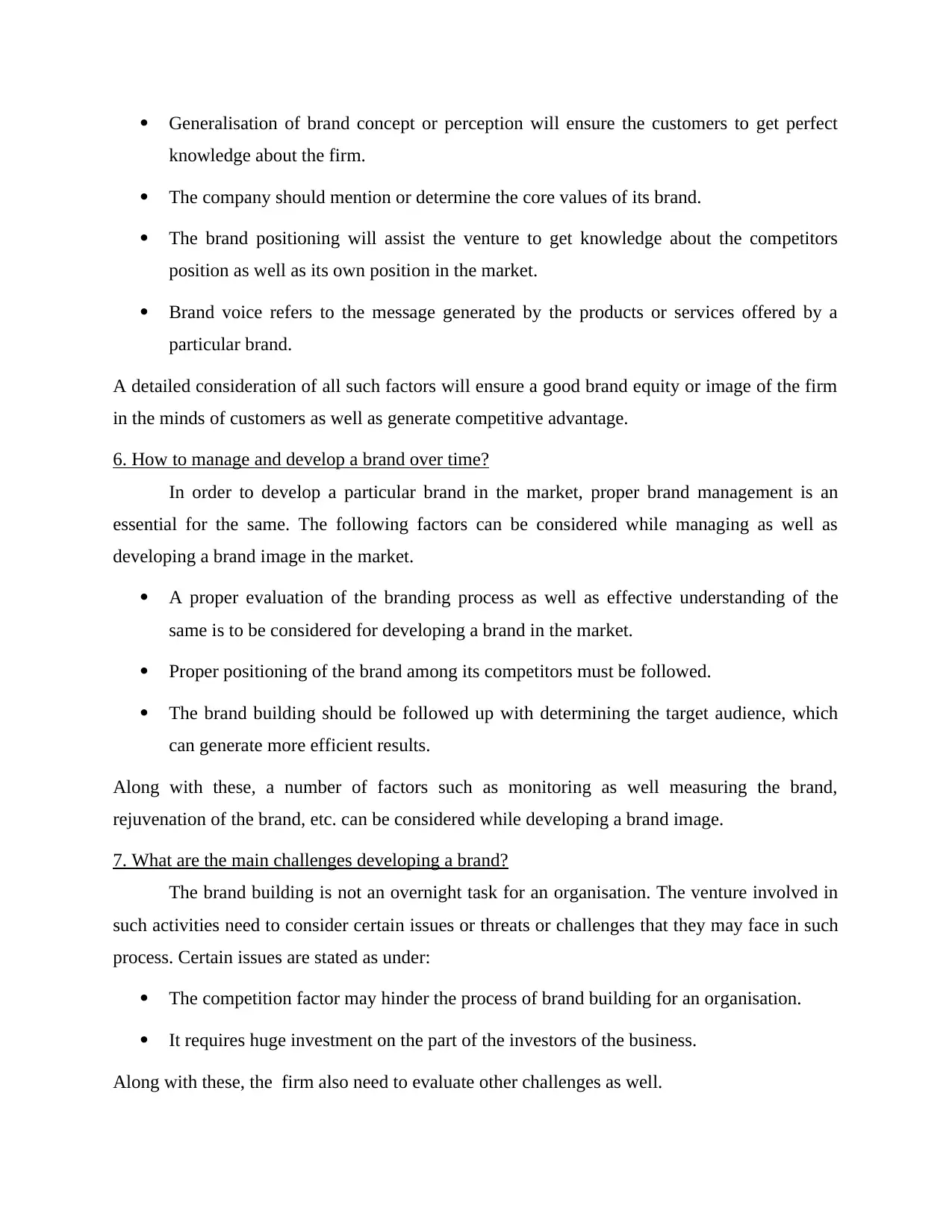
Generalisation of brand concept or perception will ensure the customers to get perfect
knowledge about the firm.
The company should mention or determine the core values of its brand.
The brand positioning will assist the venture to get knowledge about the competitors
position as well as its own position in the market.
Brand voice refers to the message generated by the products or services offered by a
particular brand.
A detailed consideration of all such factors will ensure a good brand equity or image of the firm
in the minds of customers as well as generate competitive advantage.
6. How to manage and develop a brand over time?
In order to develop a particular brand in the market, proper brand management is an
essential for the same. The following factors can be considered while managing as well as
developing a brand image in the market.
A proper evaluation of the branding process as well as effective understanding of the
same is to be considered for developing a brand in the market.
Proper positioning of the brand among its competitors must be followed.
The brand building should be followed up with determining the target audience, which
can generate more efficient results.
Along with these, a number of factors such as monitoring as well measuring the brand,
rejuvenation of the brand, etc. can be considered while developing a brand image.
7. What are the main challenges developing a brand?
The brand building is not an overnight task for an organisation. The venture involved in
such activities need to consider certain issues or threats or challenges that they may face in such
process. Certain issues are stated as under:
The competition factor may hinder the process of brand building for an organisation.
It requires huge investment on the part of the investors of the business.
Along with these, the firm also need to evaluate other challenges as well.
knowledge about the firm.
The company should mention or determine the core values of its brand.
The brand positioning will assist the venture to get knowledge about the competitors
position as well as its own position in the market.
Brand voice refers to the message generated by the products or services offered by a
particular brand.
A detailed consideration of all such factors will ensure a good brand equity or image of the firm
in the minds of customers as well as generate competitive advantage.
6. How to manage and develop a brand over time?
In order to develop a particular brand in the market, proper brand management is an
essential for the same. The following factors can be considered while managing as well as
developing a brand image in the market.
A proper evaluation of the branding process as well as effective understanding of the
same is to be considered for developing a brand in the market.
Proper positioning of the brand among its competitors must be followed.
The brand building should be followed up with determining the target audience, which
can generate more efficient results.
Along with these, a number of factors such as monitoring as well measuring the brand,
rejuvenation of the brand, etc. can be considered while developing a brand image.
7. What are the main challenges developing a brand?
The brand building is not an overnight task for an organisation. The venture involved in
such activities need to consider certain issues or threats or challenges that they may face in such
process. Certain issues are stated as under:
The competition factor may hinder the process of brand building for an organisation.
It requires huge investment on the part of the investors of the business.
Along with these, the firm also need to evaluate other challenges as well.
⊘ This is a preview!⊘
Do you want full access?
Subscribe today to unlock all pages.

Trusted by 1+ million students worldwide
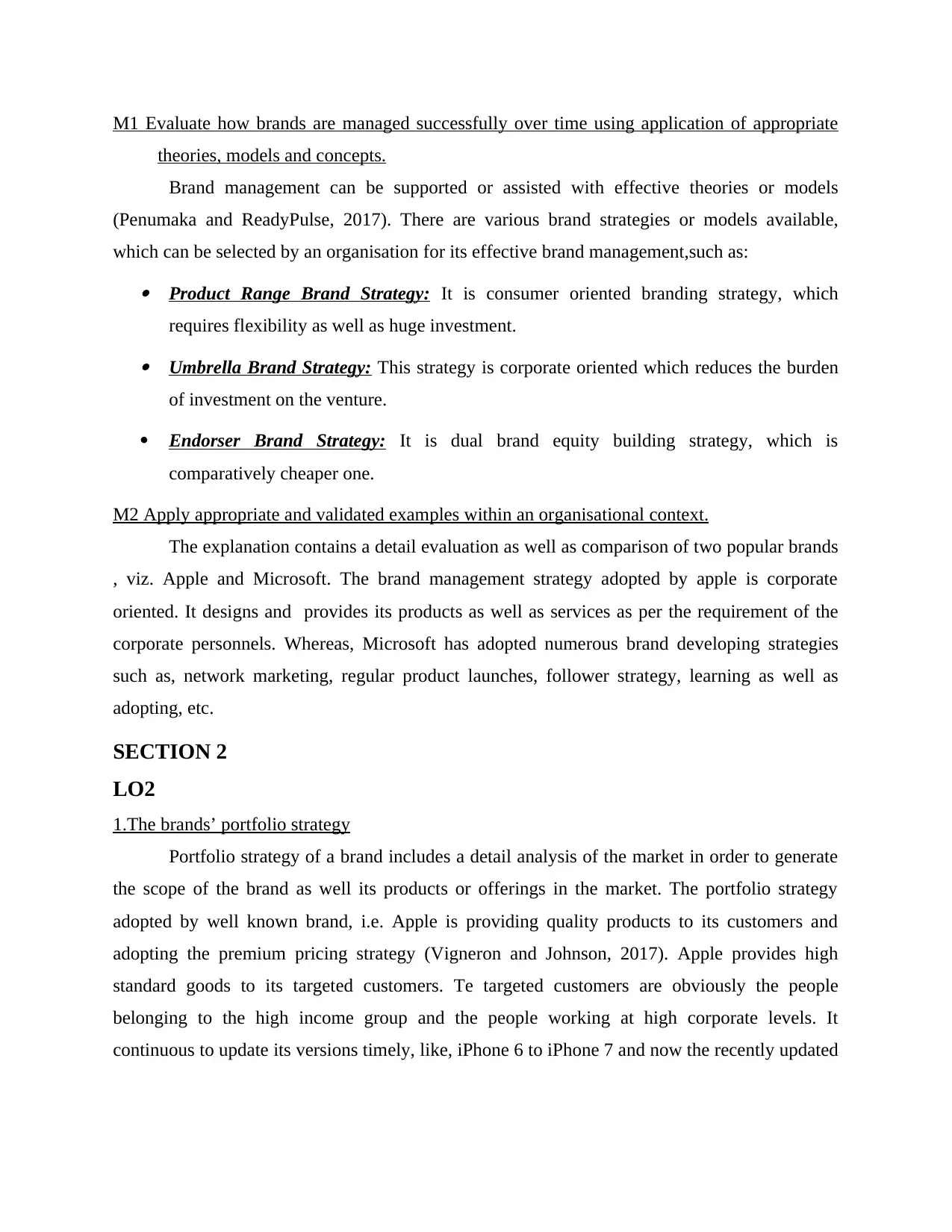
M1 Evaluate how brands are managed successfully over time using application of appropriate
theories, models and concepts.
Brand management can be supported or assisted with effective theories or models
(Penumaka and ReadyPulse, 2017). There are various brand strategies or models available,
which can be selected by an organisation for its effective brand management,such as: Product Range Brand Strategy: It is consumer oriented branding strategy, which
requires flexibility as well as huge investment. Umbrella Brand Strategy: This strategy is corporate oriented which reduces the burden
of investment on the venture.
Endorser Brand Strategy: It is dual brand equity building strategy, which is
comparatively cheaper one.
M2 Apply appropriate and validated examples within an organisational context.
The explanation contains a detail evaluation as well as comparison of two popular brands
, viz. Apple and Microsoft. The brand management strategy adopted by apple is corporate
oriented. It designs and provides its products as well as services as per the requirement of the
corporate personnels. Whereas, Microsoft has adopted numerous brand developing strategies
such as, network marketing, regular product launches, follower strategy, learning as well as
adopting, etc.
SECTION 2
LO2
1.The brands’ portfolio strategy
Portfolio strategy of a brand includes a detail analysis of the market in order to generate
the scope of the brand as well its products or offerings in the market. The portfolio strategy
adopted by well known brand, i.e. Apple is providing quality products to its customers and
adopting the premium pricing strategy (Vigneron and Johnson, 2017). Apple provides high
standard goods to its targeted customers. Te targeted customers are obviously the people
belonging to the high income group and the people working at high corporate levels. It
continuous to update its versions timely, like, iPhone 6 to iPhone 7 and now the recently updated
theories, models and concepts.
Brand management can be supported or assisted with effective theories or models
(Penumaka and ReadyPulse, 2017). There are various brand strategies or models available,
which can be selected by an organisation for its effective brand management,such as: Product Range Brand Strategy: It is consumer oriented branding strategy, which
requires flexibility as well as huge investment. Umbrella Brand Strategy: This strategy is corporate oriented which reduces the burden
of investment on the venture.
Endorser Brand Strategy: It is dual brand equity building strategy, which is
comparatively cheaper one.
M2 Apply appropriate and validated examples within an organisational context.
The explanation contains a detail evaluation as well as comparison of two popular brands
, viz. Apple and Microsoft. The brand management strategy adopted by apple is corporate
oriented. It designs and provides its products as well as services as per the requirement of the
corporate personnels. Whereas, Microsoft has adopted numerous brand developing strategies
such as, network marketing, regular product launches, follower strategy, learning as well as
adopting, etc.
SECTION 2
LO2
1.The brands’ portfolio strategy
Portfolio strategy of a brand includes a detail analysis of the market in order to generate
the scope of the brand as well its products or offerings in the market. The portfolio strategy
adopted by well known brand, i.e. Apple is providing quality products to its customers and
adopting the premium pricing strategy (Vigneron and Johnson, 2017). Apple provides high
standard goods to its targeted customers. Te targeted customers are obviously the people
belonging to the high income group and the people working at high corporate levels. It
continuous to update its versions timely, like, iPhone 6 to iPhone 7 and now the recently updated
Paraphrase This Document
Need a fresh take? Get an instant paraphrase of this document with our AI Paraphraser
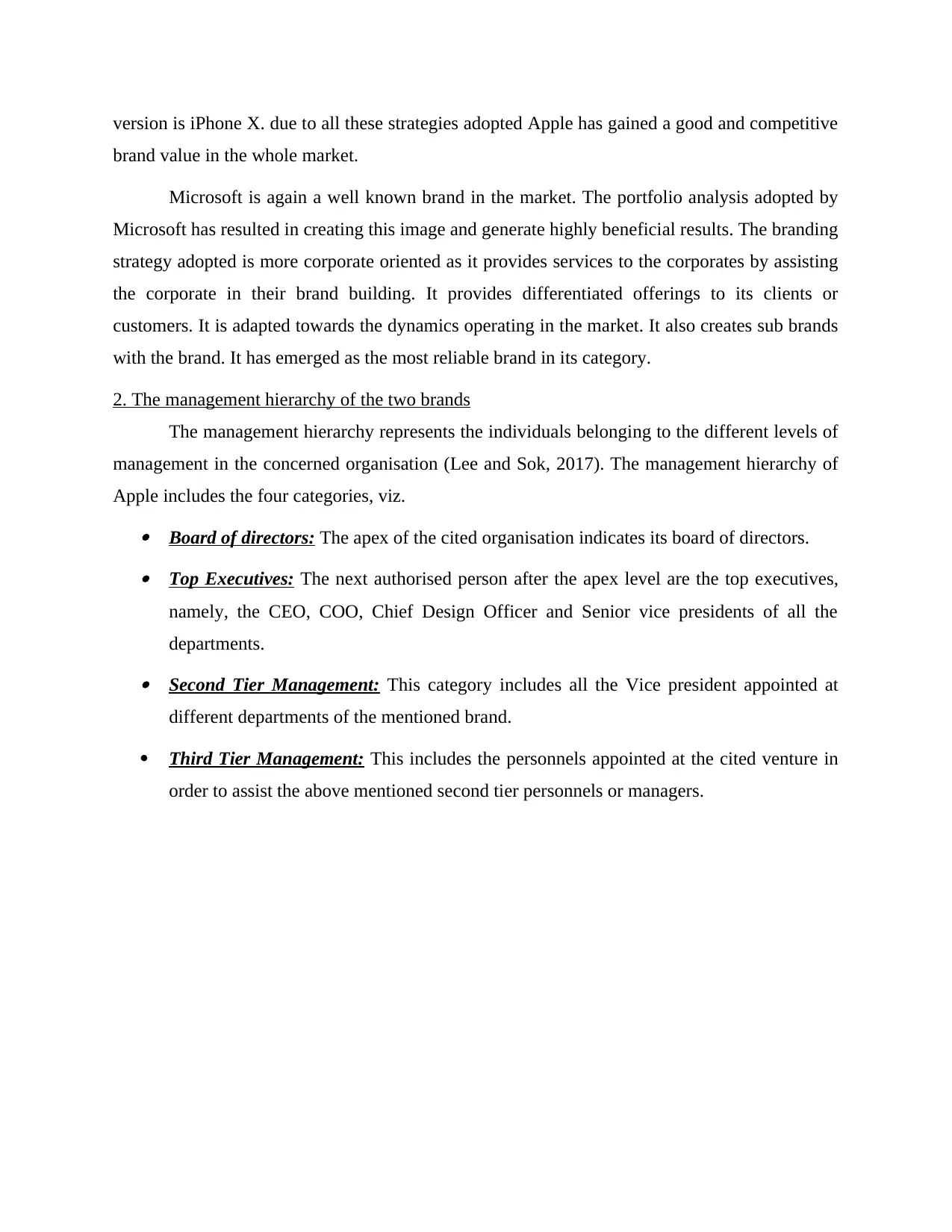
version is iPhone X. due to all these strategies adopted Apple has gained a good and competitive
brand value in the whole market.
Microsoft is again a well known brand in the market. The portfolio analysis adopted by
Microsoft has resulted in creating this image and generate highly beneficial results. The branding
strategy adopted is more corporate oriented as it provides services to the corporates by assisting
the corporate in their brand building. It provides differentiated offerings to its clients or
customers. It is adapted towards the dynamics operating in the market. It also creates sub brands
with the brand. It has emerged as the most reliable brand in its category.
2. The management hierarchy of the two brands
The management hierarchy represents the individuals belonging to the different levels of
management in the concerned organisation (Lee and Sok, 2017). The management hierarchy of
Apple includes the four categories, viz. Board of directors: The apex of the cited organisation indicates its board of directors. Top Executives: The next authorised person after the apex level are the top executives,
namely, the CEO, COO, Chief Design Officer and Senior vice presidents of all the
departments. Second Tier Management: This category includes all the Vice president appointed at
different departments of the mentioned brand.
Third Tier Management: This includes the personnels appointed at the cited venture in
order to assist the above mentioned second tier personnels or managers.
brand value in the whole market.
Microsoft is again a well known brand in the market. The portfolio analysis adopted by
Microsoft has resulted in creating this image and generate highly beneficial results. The branding
strategy adopted is more corporate oriented as it provides services to the corporates by assisting
the corporate in their brand building. It provides differentiated offerings to its clients or
customers. It is adapted towards the dynamics operating in the market. It also creates sub brands
with the brand. It has emerged as the most reliable brand in its category.
2. The management hierarchy of the two brands
The management hierarchy represents the individuals belonging to the different levels of
management in the concerned organisation (Lee and Sok, 2017). The management hierarchy of
Apple includes the four categories, viz. Board of directors: The apex of the cited organisation indicates its board of directors. Top Executives: The next authorised person after the apex level are the top executives,
namely, the CEO, COO, Chief Design Officer and Senior vice presidents of all the
departments. Second Tier Management: This category includes all the Vice president appointed at
different departments of the mentioned brand.
Third Tier Management: This includes the personnels appointed at the cited venture in
order to assist the above mentioned second tier personnels or managers.

Illustration 1: management hierarchy of Apple.in
source: www.hierarchystructure.com
source: www.hierarchystructure.com
⊘ This is a preview!⊘
Do you want full access?
Subscribe today to unlock all pages.

Trusted by 1+ million students worldwide
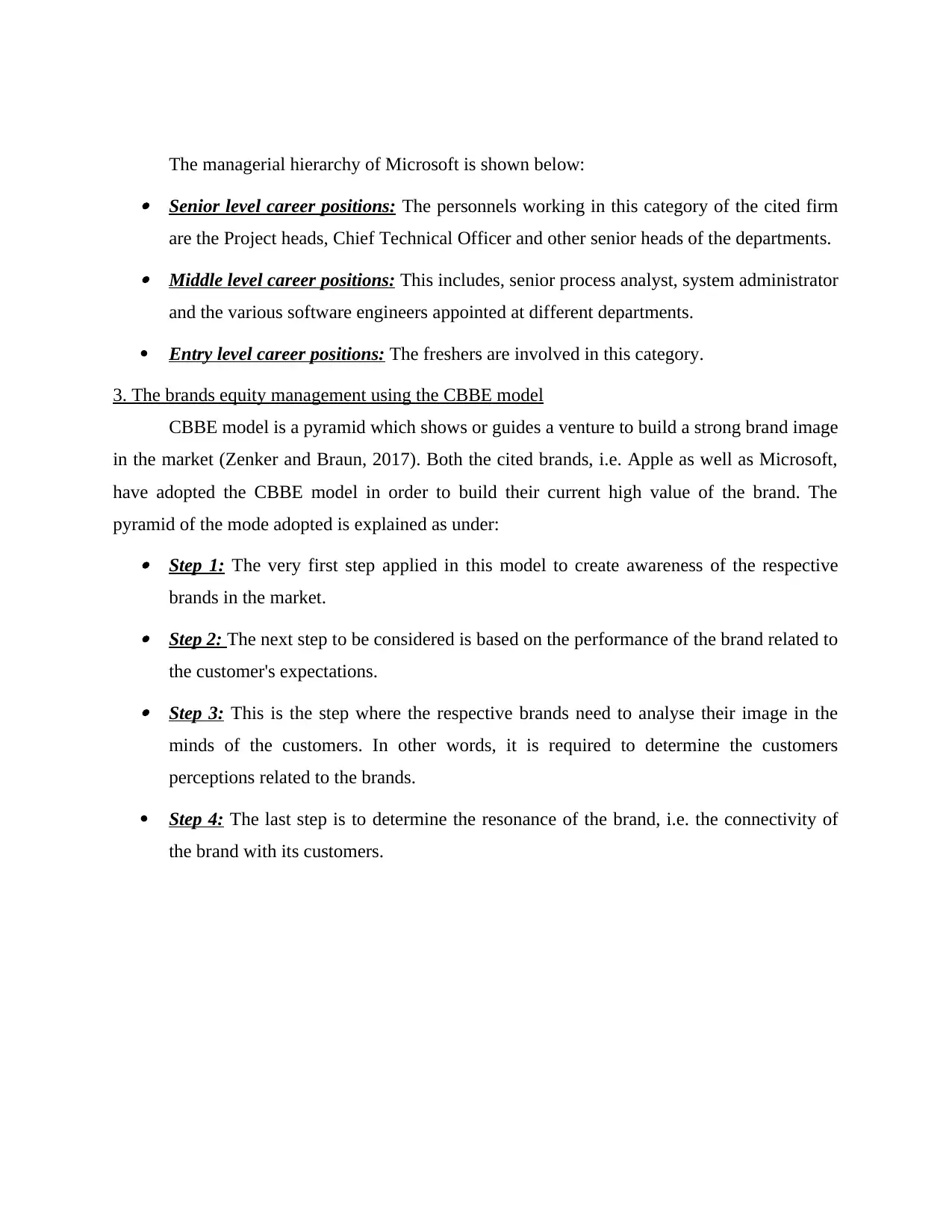
The managerial hierarchy of Microsoft is shown below: Senior level career positions: The personnels working in this category of the cited firm
are the Project heads, Chief Technical Officer and other senior heads of the departments. Middle level career positions: This includes, senior process analyst, system administrator
and the various software engineers appointed at different departments.
Entry level career positions: The freshers are involved in this category.
3. The brands equity management using the CBBE model
CBBE model is a pyramid which shows or guides a venture to build a strong brand image
in the market (Zenker and Braun, 2017). Both the cited brands, i.e. Apple as well as Microsoft,
have adopted the CBBE model in order to build their current high value of the brand. The
pyramid of the mode adopted is explained as under: Step 1: The very first step applied in this model to create awareness of the respective
brands in the market. Step 2: The next step to be considered is based on the performance of the brand related to
the customer's expectations. Step 3: This is the step where the respective brands need to analyse their image in the
minds of the customers. In other words, it is required to determine the customers
perceptions related to the brands.
Step 4: The last step is to determine the resonance of the brand, i.e. the connectivity of
the brand with its customers.
are the Project heads, Chief Technical Officer and other senior heads of the departments. Middle level career positions: This includes, senior process analyst, system administrator
and the various software engineers appointed at different departments.
Entry level career positions: The freshers are involved in this category.
3. The brands equity management using the CBBE model
CBBE model is a pyramid which shows or guides a venture to build a strong brand image
in the market (Zenker and Braun, 2017). Both the cited brands, i.e. Apple as well as Microsoft,
have adopted the CBBE model in order to build their current high value of the brand. The
pyramid of the mode adopted is explained as under: Step 1: The very first step applied in this model to create awareness of the respective
brands in the market. Step 2: The next step to be considered is based on the performance of the brand related to
the customer's expectations. Step 3: This is the step where the respective brands need to analyse their image in the
minds of the customers. In other words, it is required to determine the customers
perceptions related to the brands.
Step 4: The last step is to determine the resonance of the brand, i.e. the connectivity of
the brand with its customers.
Paraphrase This Document
Need a fresh take? Get an instant paraphrase of this document with our AI Paraphraser
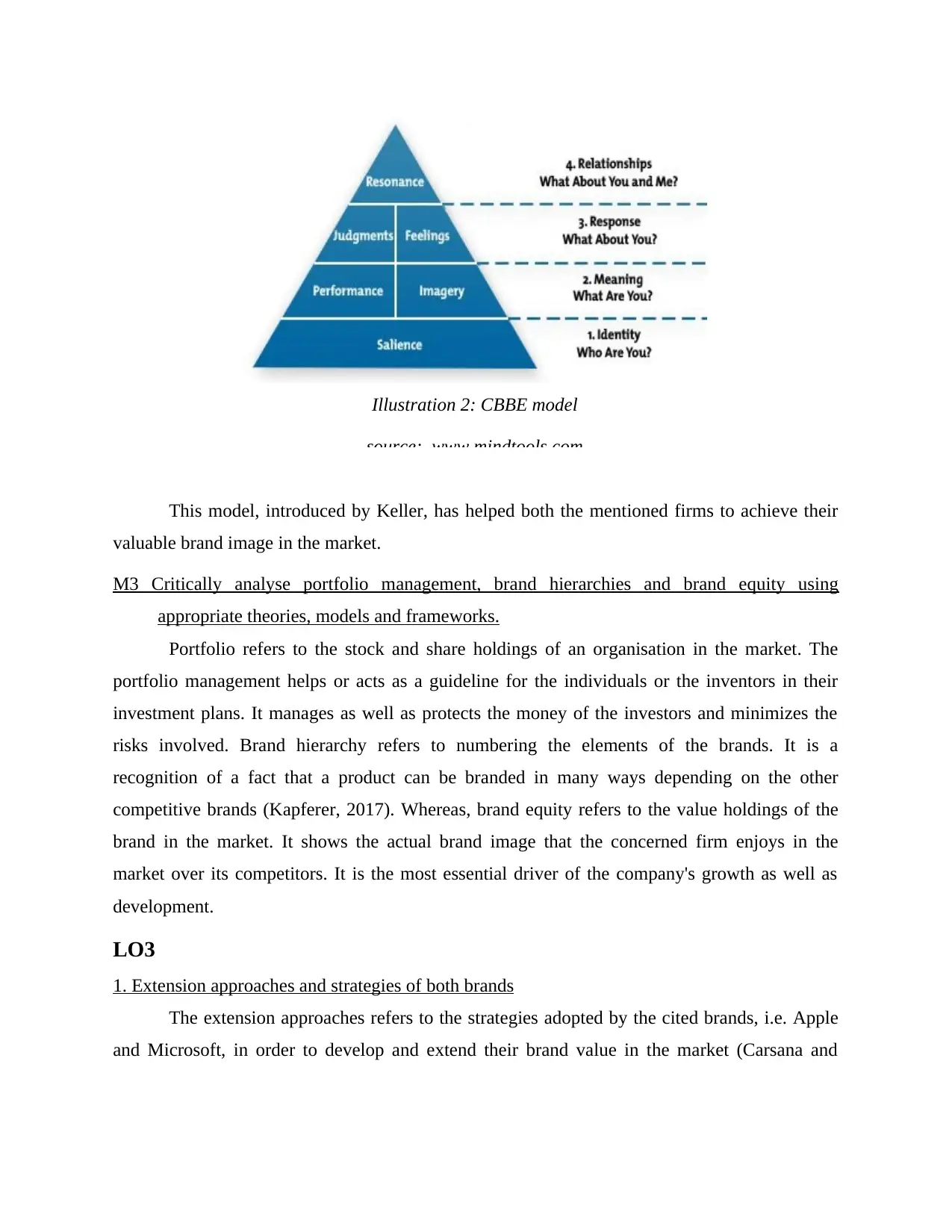
This model, introduced by Keller, has helped both the mentioned firms to achieve their
valuable brand image in the market.
M3 Critically analyse portfolio management, brand hierarchies and brand equity using
appropriate theories, models and frameworks.
Portfolio refers to the stock and share holdings of an organisation in the market. The
portfolio management helps or acts as a guideline for the individuals or the inventors in their
investment plans. It manages as well as protects the money of the investors and minimizes the
risks involved. Brand hierarchy refers to numbering the elements of the brands. It is a
recognition of a fact that a product can be branded in many ways depending on the other
competitive brands (Kapferer, 2017). Whereas, brand equity refers to the value holdings of the
brand in the market. It shows the actual brand image that the concerned firm enjoys in the
market over its competitors. It is the most essential driver of the company's growth as well as
development.
LO3
1. Extension approaches and strategies of both brands
The extension approaches refers to the strategies adopted by the cited brands, i.e. Apple
and Microsoft, in order to develop and extend their brand value in the market (Carsana and
Illustration 2: CBBE model
source: www.mindtools.com
valuable brand image in the market.
M3 Critically analyse portfolio management, brand hierarchies and brand equity using
appropriate theories, models and frameworks.
Portfolio refers to the stock and share holdings of an organisation in the market. The
portfolio management helps or acts as a guideline for the individuals or the inventors in their
investment plans. It manages as well as protects the money of the investors and minimizes the
risks involved. Brand hierarchy refers to numbering the elements of the brands. It is a
recognition of a fact that a product can be branded in many ways depending on the other
competitive brands (Kapferer, 2017). Whereas, brand equity refers to the value holdings of the
brand in the market. It shows the actual brand image that the concerned firm enjoys in the
market over its competitors. It is the most essential driver of the company's growth as well as
development.
LO3
1. Extension approaches and strategies of both brands
The extension approaches refers to the strategies adopted by the cited brands, i.e. Apple
and Microsoft, in order to develop and extend their brand value in the market (Carsana and
Illustration 2: CBBE model
source: www.mindtools.com
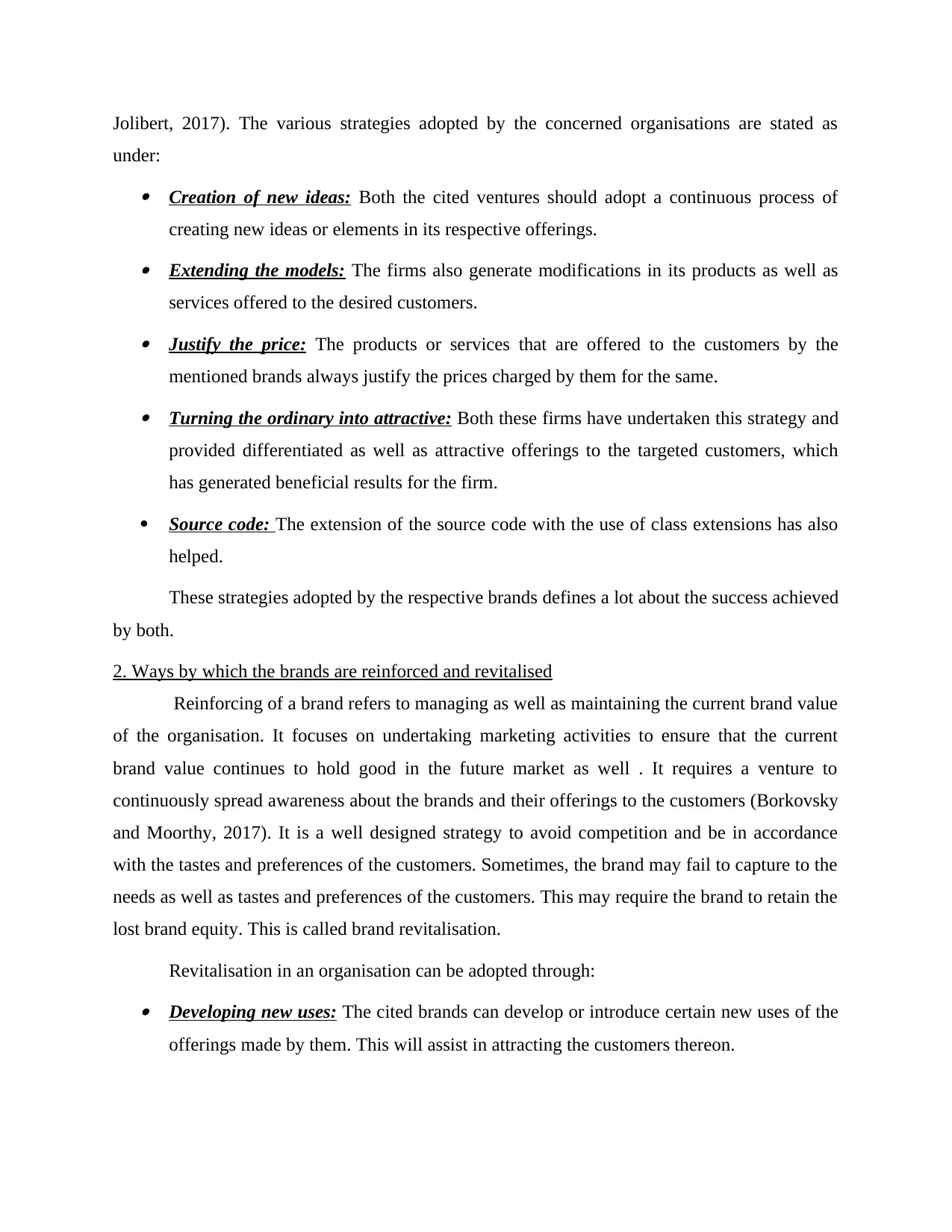
Jolibert, 2017). The various strategies adopted by the concerned organisations are stated as
under: Creation of new ideas: Both the cited ventures should adopt a continuous process of
creating new ideas or elements in its respective offerings. Extending the models: The firms also generate modifications in its products as well as
services offered to the desired customers. Justify the price: The products or services that are offered to the customers by the
mentioned brands always justify the prices charged by them for the same. Turning the ordinary into attractive: Both these firms have undertaken this strategy and
provided differentiated as well as attractive offerings to the targeted customers, which
has generated beneficial results for the firm.
Source code: The extension of the source code with the use of class extensions has also
helped.
These strategies adopted by the respective brands defines a lot about the success achieved
by both.
2. Ways by which the brands are reinforced and revitalised
Reinforcing of a brand refers to managing as well as maintaining the current brand value
of the organisation. It focuses on undertaking marketing activities to ensure that the current
brand value continues to hold good in the future market as well . It requires a venture to
continuously spread awareness about the brands and their offerings to the customers (Borkovsky
and Moorthy, 2017). It is a well designed strategy to avoid competition and be in accordance
with the tastes and preferences of the customers. Sometimes, the brand may fail to capture to the
needs as well as tastes and preferences of the customers. This may require the brand to retain the
lost brand equity. This is called brand revitalisation.
Revitalisation in an organisation can be adopted through: Developing new uses: The cited brands can develop or introduce certain new uses of the
offerings made by them. This will assist in attracting the customers thereon.
under: Creation of new ideas: Both the cited ventures should adopt a continuous process of
creating new ideas or elements in its respective offerings. Extending the models: The firms also generate modifications in its products as well as
services offered to the desired customers. Justify the price: The products or services that are offered to the customers by the
mentioned brands always justify the prices charged by them for the same. Turning the ordinary into attractive: Both these firms have undertaken this strategy and
provided differentiated as well as attractive offerings to the targeted customers, which
has generated beneficial results for the firm.
Source code: The extension of the source code with the use of class extensions has also
helped.
These strategies adopted by the respective brands defines a lot about the success achieved
by both.
2. Ways by which the brands are reinforced and revitalised
Reinforcing of a brand refers to managing as well as maintaining the current brand value
of the organisation. It focuses on undertaking marketing activities to ensure that the current
brand value continues to hold good in the future market as well . It requires a venture to
continuously spread awareness about the brands and their offerings to the customers (Borkovsky
and Moorthy, 2017). It is a well designed strategy to avoid competition and be in accordance
with the tastes and preferences of the customers. Sometimes, the brand may fail to capture to the
needs as well as tastes and preferences of the customers. This may require the brand to retain the
lost brand equity. This is called brand revitalisation.
Revitalisation in an organisation can be adopted through: Developing new uses: The cited brands can develop or introduce certain new uses of the
offerings made by them. This will assist in attracting the customers thereon.
⊘ This is a preview!⊘
Do you want full access?
Subscribe today to unlock all pages.

Trusted by 1+ million students worldwide
1 out of 20
Related Documents
Your All-in-One AI-Powered Toolkit for Academic Success.
+13062052269
info@desklib.com
Available 24*7 on WhatsApp / Email
![[object Object]](/_next/static/media/star-bottom.7253800d.svg)
Unlock your academic potential
Copyright © 2020–2025 A2Z Services. All Rights Reserved. Developed and managed by ZUCOL.



